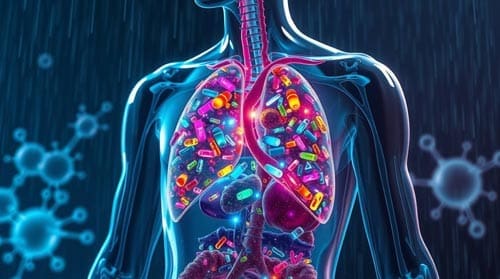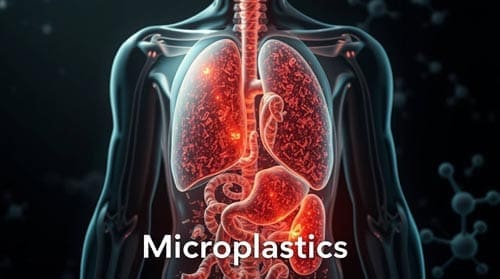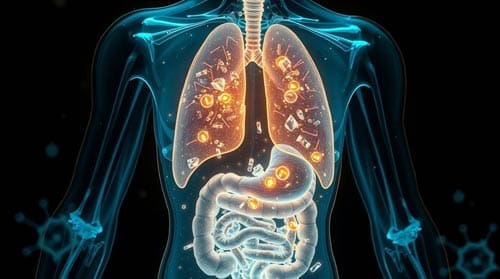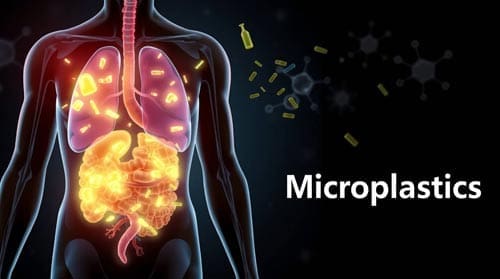Long-term Health Concerns of Microplastics
Please like and subscribe if you enjoyed this video 🙂
Video Overview
This video looks at the possible long-term health effects of microplastics on humans. Microplastics are tiny plastic pieces that have spread throughout our environment. We review current research on how microplastics enter the human body and their potential impacts on different body systems. The video also discusses gaps in our knowledge and areas needing more study. Overall, while research is still ongoing, there are reasons to be concerned about microplastics affecting human health over time.
Introduction
Microplastics are very small plastic pieces less than 5 millimeters in size. They come from larger plastic items breaking down or are made small on purpose, like microbeads in some products. These tiny plastics have spread widely in our environment – they’re found in the air, water, soil, and even inside living things.
As plastic use has grown hugely over recent decades, so has the amount of microplastic pollution. This has raised worries about whether breathing in or eating microplastics could harm human health, especially over many years of exposure. This video looks at what we currently know about the possible long-term health effects of microplastics on people.

How Microplastics Enter the Human Body
There are several ways that microplastics can get into our bodies:
1. Through food and drink: Microplastics have been found in many foods and drinks, including fish, shellfish, salt, beer, and tap water. When we eat or drink these, we may also consume the microplastics in them.
2. By breathing: Tiny microplastic particles float in the air, especially indoors. We can breathe these in without realizing it.
3. Through the skin: Some scientists think microplastics might be able to enter our bodies through our skin, but more research is needed on this.
Once inside the body, microplastics can move to different organs and tissues. They’ve been found in human blood, lungs, and even the placenta of unborn babies.
Potential Health Effects of Microplastics
While research is still ongoing, there are several ways that microplastics might affect human health over time:
1. Physical damage
Microplastics could physically damage organs or tissues. For example, sharp edges of plastic particles might scratch or irritate the lining of the gut or lungs. Over time, this could lead to inflammation or other problems.
2. Chemical effects
Many plastics contain chemicals that can be harmful to health. As microplastics break down in the body, they might release these chemicals. Some of these chemicals can interfere with hormones or cause other health issues.
3. Carrier for other pollutants
Microplastics can attract and hold onto other harmful substances in the environment, like pesticides or heavy metals. When microplastics enter the body, they might bring these toxins with them.
4. Effects on the immune system
Some studies suggest that microplastics might affect how our immune system works. This could make us more likely to get sick or develop allergies.
5. Impacts on the gut
Microplastics in the gut might change the balance of bacteria there. This could affect how we digest food and possibly lead to gut inflammation or other digestive problems.
6. Possible cancer risk
While there’s no direct evidence yet, some scientists worry that long-term exposure to microplastics and their associated chemicals could increase cancer risk.

Specific Health Concerns
Let’s look more closely at how microplastics might affect different parts of the body:
Digestive System
The digestive system is likely exposed to the most microplastics through the food and drinks we consume. Potential long-term effects include:
Chronic inflammation of the gut lining.
Changes in the gut microbiome (the helpful bacteria in our intestines).
Increased risk of gastrointestinal diseases.
Respiratory System
We can breathe in microplastics floating in the air. Over time, this might lead to:
Inflammation in the lungs.
Increased risk of respiratory infections.
Possible worsening of conditions like asthma.
Cardiovascular System
Tiny microplastics have been found in human blood. This raises concerns about:
Potential damage to blood vessels.
Increased risk of heart disease or stroke.
Reproductive System
Some chemicals in plastics can affect hormones. Long-term exposure might lead to:
Fertility problems.
Developmental issues in unborn babies.
Immune System
Microplastics might affect how our body fights off illness:
Changes in immune responses.
Increased risk of allergies or autoimmune diseases.
Brain and Nervous System
There’s concern that very small microplastics might be able to cross the blood-brain barrier:
Potential impacts on brain function.
Possible links to neurodegenerative diseases.
Challenges in Studying Long-term Effects
Studying the long-term health effects of microplastics is difficult for several reasons:
1. Time factor: It can take many years for health problems to show up, making it hard to link them directly to microplastic exposure.
2. Many variables: People are exposed to many different things that can affect their health. It’s hard to separate the effects of microplastics from other factors.
3. Ethical concerns: We can’t deliberately expose people to potentially harmful substances for research.
4. Lack of standardized methods: There isn’t a standard way to measure microplastic exposure or its effects, making it hard to compare different studies.
5. Different types of plastics: There are many types of microplastics, each with different properties. This makes it challenging to study their effects as a whole.
Current Research Gaps
While we’re learning more about microplastics, there are still many things we don’t know:
1. Safe levels of exposure: We don’t know how much microplastic exposure is safe for humans over the long term.
2. Most harmful types: Some types of microplastics might be more dangerous than others, but we’re not sure which ones.
3. Interactions with other pollutants: We need to understand better how microplastics interact with other environmental toxins.
4. Effects on vulnerable groups: More research is needed on how microplastics might affect children, pregnant women, or people with certain health conditions.
5. Long-term accumulation: We don’t fully understand how microplastics build up in the body over time and what this might mean for health.
Potential Solutions and Prevention
While research continues, there are steps we can take to reduce microplastic pollution and exposure:
1. Reduce plastic use: Using less plastic, especially single-use items, can help reduce the amount of microplastics in the environment.
2. Improve waste management: Better recycling and waste disposal systems can prevent plastics from breaking down into microplastics.
3. Develop alternatives: Creating biodegradable materials to replace plastics could help reduce microplastic pollution.
4. Filter drinking water: Using water filters can help remove microplastics from drinking water.
5. Choose natural fabrics: Synthetic fabrics like polyester release microfibers when washed. Choosing natural fabrics can help reduce this.
6. Support research: Continued research is crucial to understanding and addressing the long-term health impacts of microplastics.


Conclusion
The long-term health effects of microplastics are a growing concern. While we don’t yet have all the answers, there’s enough evidence to suggest that microplastics could potentially harm human health over time. They may affect various body systems, from our digestive tract to our lungs and even our brains.
However, it’s important to note that research in this area is still ongoing. Many of the potential health effects are based on laboratory studies or animal research, and we need more long-term studies on humans to fully understand the risks.
Despite the challenges in studying this issue, the potential health concerns highlight the need to address microplastic pollution. Reducing plastic use, improving waste management, and supporting further research are all important steps.
As we continue to learn more about microplastics and health, it’s likely that this will remain an important public health issue in the coming years. Healthcare professionals, researchers, and policymakers will need to work together to better understand and address the long-term health concerns of microplastics.
References:
-
World Health Organization. (2019). Microplastics in drinking-water.
-
Prata, J. C., da Costa, J. P., Lopes, I., Duarte, A. C., & Rocha-Santos, T. (2020). Environmental exposure to microplastics: An overview on possible human health effects. Science of The Total Environment, 702, 134455.
-
Ragusa, A., Svelato, A., Santacroce, C., Catalano, P., Notarstefano, V., Carnevali, O., … & Giorgini, E. (2021). Plasticenta: First evidence of microplastics in human placenta. Environment International, 146, 106274.
-
Wright, S. L., & Kelly, F. J. (2017). Plastic and human health: a micro issue?. Environmental science & technology, 51(12), 6634-6647.
-
Campanale, C., Massarelli, C., Savino, I., Locaputo, V., & Uricchio, V. F. (2020). A detailed review study on potential effects of microplastics and additives of concern on human health. International journal of environmental research and public health, 17(4), 1212.
-
Vethaak, A. D., & Legler, J. (2021). Microplastics and human health. Science, 371(6530), 672-674.
-
Leslie, H. A., van Velzen, M. J., Brandsma, S. H., Vethaak, A. D., Garcia-Vallejo, J. J., & Lamoree, M. H. (2022). Discovery and quantification of plastic particle pollution in human blood. Environment international, 163, 107199.
-
Hwang, J., Choi, D., Han, S., Choi, J., & Hong, J. (2019). An assessment of the toxicity of polypropylene microplastics in human derived cells. Science of The Total Environment, 684, 657-669.
-
Gasperi, J., Wright, S. L., Dris, R., Collard, F., Mandin, C., Guerrouache, M., … & Tassin, B. (2018). Microplastics in air: are we breathing it in?. Current Opinion in Environmental Science & Health, 1, 1-5.
-
Rochman, C. M., Tahir, A., Williams, S. L., Baxa, D. V., Lam, R., Miller, J. T., … & Teh, S. J. (2015). Anthropogenic debris in seafood: Plastic debris and fibers from textiles in fish and bivalves sold for human consumption. Scientific reports, 5(1), 1-10.

